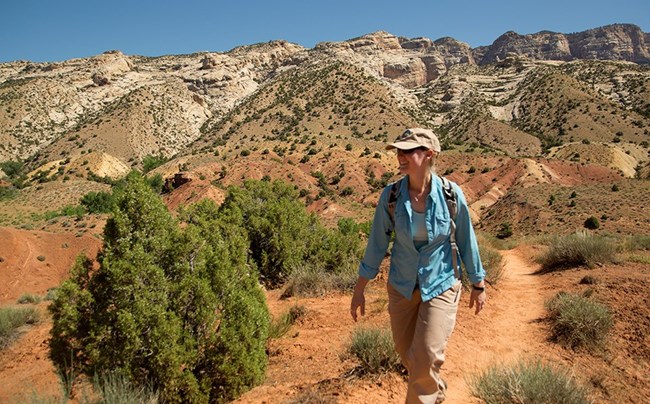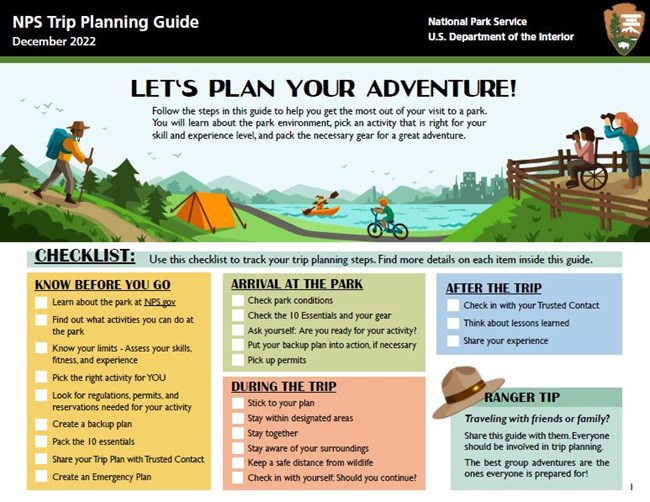Last updated: June 29, 2023
Article
Beat the Heat: Prevent Heat-Related Illnesses

NPS Photo
Recreating in national parks this summer? Don't let the heat ruin your trip!
Heat-related illness can cause symptoms from heat rash to heat stroke. You may need at least a full day of rest to recover or a visit to the hospital. This could ruin your whole trip and we don't want that to happen!
Beat the Heat by learning:
What is a Heat-Related Illness?
Heat-related illnesses are caused by your body's inability to cool down properly. The body normally cools itself by sweating, but sometimes sweating just isn't enough. When this happens, the body's temperature rises which can lead to brain damage or injure vital organs. Heat-related illnesses range from treatable symptoms, like heat rash and sunburns, to heat stroke which can lead to death if not treated quickly.
Did you know that your risk of heat-related illness increases with the following:
Does not allow sweat to evaporate as quickly, preventing the body from releasing heat quickly.
Increases your chances of getting dehydrated and sunburned.
Participating in strenuous physical activities, such as hiking or biking, in hot weather can make it difficult for your body to cool off, especially you aren’t used to performing the exercise at an extreme temperature.
- Age (infants, young children, people over 65)
- Obesity
- Heart disease
- Poor circulation
- Fever
- Mental illness
- Dehydration
- Sunburn
- Prescription drug and alcohol use
Plan for the Heat
Familiarize yourself with the different types of heat-related illnesses, their symptoms, and what to do if you experience them.
Visit the park’s website or call the park to learn about the elevation, humidity, and severe weather hazards (e.g. extreme heat) you might encounter.
Consider your skills, experience, physical fitness, and any medical conditions that might be worsened by high temperatures. Strenuous activities can increase your risk of heat-related illness.
Visit weather.gov and stop by the visitor center for information on heat alerts and high temperatures expected during your visit. If extreme heat is forecasted, schedule your activity for a cooler part of the day or plan to go out another day.
Find where to access drinking water at the park and along your trip route. Are there refilling stations for drinking water? If a natural water source is available, does it require purification and do you have the necessary tools for it? If there are none, you will need to bring enough water with you for your trip.
These are the coolest times of the day. Check the park website for tips on when to go and how to avoid the hottest temperatures
Indoor activities like exploring a park museum or interpretive exhibit at the visitor center are great back up plans for days with extreme heat so you don’t cancel the trip altogether. You can also spend the day under a nice a shady tree picnicking or relaxing and enjoying the view.
Allow several days for your body to get used to high elevation before starting your activity. Check out these tips at the CDC on ways to acclimate to a park with high elevation.
Pack for the Heat
Bring enough water to drink with you for the duration of your trip.
To replace the electrolytes you lose through sweat during your activity.
Sunscreen, a hat, and sunglasses to minimize exposure to the sun and prevent damage from UV light.
Dark colors can absorb heat from the sun and increase your body temperature.
During Your Activity
These are the coolest times of the day.
Apply sunscreen and wear sunglasses and a hat.
Stay hydrated and drink before you feel thirsty. The amount of water you need may increase if you are doing a strenuous activity.
Salty snacks replace the electrolytes your body loses when you sweat. This is especially important when you are recreating in the heat which increases how much you sweat.
Take frequent breaks to give your body a rest. Rest under shade whenever possible to help your body cool off.
Soak a towel or a shirt in water to keep you cool. If water is available, consider completely soaking yourself to keep cool. The water can cool off your body and lessen the effects of heat.
Many parks have rivers or lakes that might look like an inviting place to cool down, but in reality are very dangerous. Many of these water bodies are very deceptive: the shoreline may have slippery rocks, and there may be strong currents and cold water temperatures that could lead to injury or death. Follow park rules and regulations on swimming or wading.
Use your backup plan if you get to the park and it is too hot to do your planned activity. This way you can enjoy your visit while avoiding heat-related illness.
Stop and turn around if it gets too hot during your activity. You can always put your backup plan into action and have a wonderful experience at the park.
IMPORTANT: Always check your car for your children and pets, especially the backseat, before you lock your doors and walk away. Do not leave children or pets in a parked vehicle. The temperature in a car can rise almost 20 degrees Fahrenheit in 10 minutes! Leaving a window cracked or open is not enough to stop the quick rise in temperatures. Children, who are left unattended, are at the greatest risk of heat illness that could quickly lead to death. Learn more at NHTSA on how to prevent heat stroke in cars.
What to do when experiencing a Heat-Related Illness
-
Stop what you are doing
-
Move to a cool, shaded area
-
Call 9-1-1 or flag down a ranger for help
-
Follow CDC recommendations for addressing Heat-Related Illnesess. Drink water if you are experiencing heat exhaustion while waiting for emergency responders.
-
Cool down by splashing or soaking yourself with water, if available, and fanning vigorously

